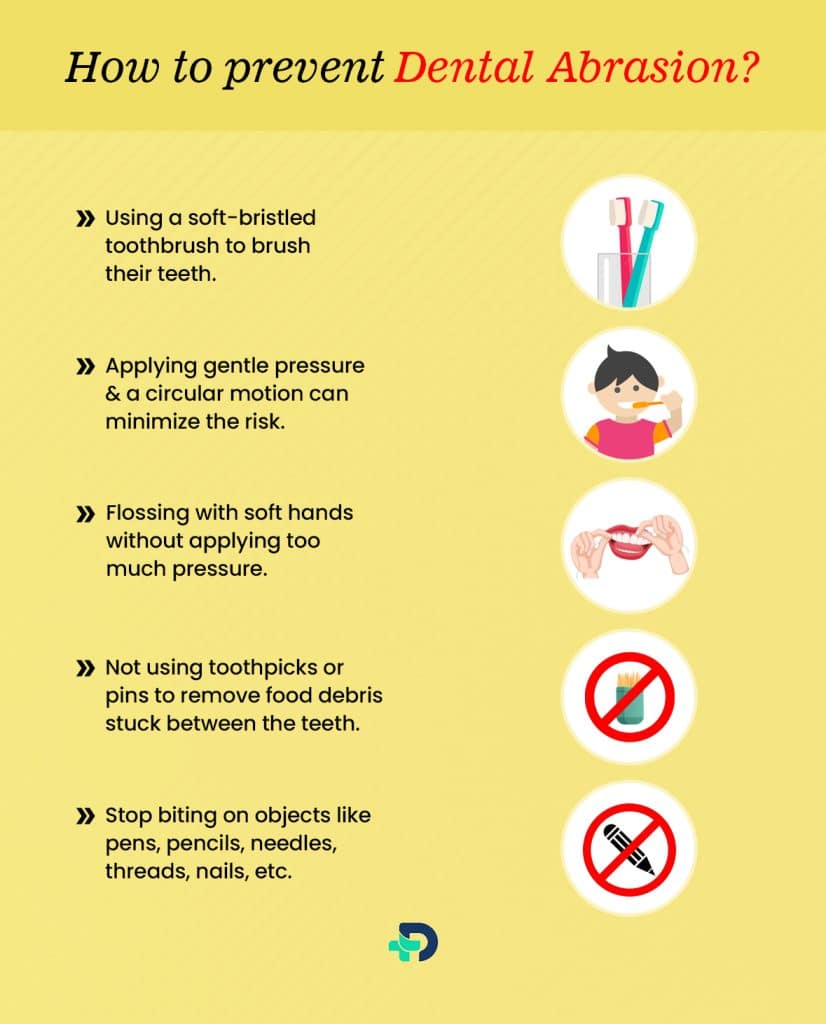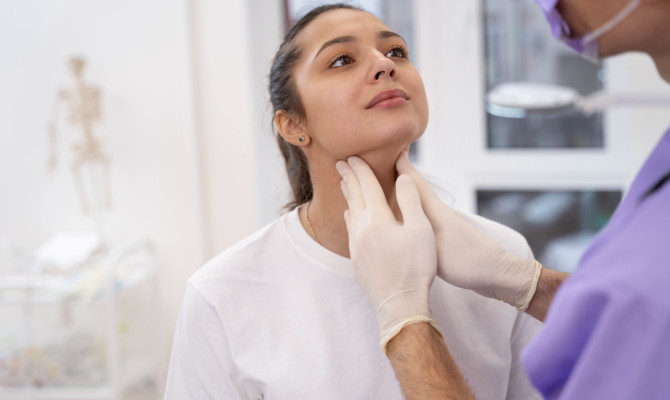Dental Abrasion: Symptoms, Causes, and Treatment

- 17 Aug 2023
Overview
What is Dental abrasion?
Dental abrasion is the tooth structure loss due to mechanical friction from external materials.1Overview| Researched based study from Nlm.nih.gov It is also called a cervical abrasion or tooth abrasion. Abrasion generally happens on the teeth near the gum line but can occur on any part of the teeth. Our general health and dental health are critically connected. However, various factors can affect the integrity of our teeth, one of them being dental abrasion. This condition can lead to tooth sensitivity, cosmetic concerns, and potential oral health complications.
This article will explore the symptoms, causes, complications, preventive measures, diagnosis, and treatment options for dental abrasion.

Symptoms
Symptoms of Dental abrasion
Signs and symptoms of dental abrasion may include:
- Tooth Sensitivity
- Tooth discoloration
- Notches or grooves on the teeth
- Receded gums
- Swollen and bleeding gums
- Damaged toothbrush bristles
Tooth Sensitivity
- May result from dental abrasion, particularly when ingesting cold, hot, or acidic foods and beverages.
- Dentin exposure, which contains microscopic tubules that connect to the tooth’s nerves, can trigger discomfort or pain.2Symptoms| Researched based study from Nlm.nih.gov
Tooth Discoloration
- As the enamel wears away, the underlying dentin becomes more visible, resulting in the affected teeth’ yellowish or grayish appearance.
- This cosmetic concern can significantly impact a person’s smile and self-confidence.
Notched Tooth Edges
- Dental abrasion often leads to distinctive notches or grooves on the tooth surface, particularly near the gum line.
- These notches are commonly found on the front teeth, with more prominent brushing forces.
Gum Recession
- The repetitive mechanical trauma associated with dental abrasion can cause the gums to recede2Symptoms| Researched based study from Nlm.nih.gov
- As the gum tissue pulls away from the tooth, the tooth roots become exposed, making them susceptible to tooth sensitivity and further damage.
Damaged toothbrush bristles
- The Toothbrush’s bristles can be curled up or frayed, which is a sign of overzealous brushing, and the Toothbrush needs to be replaced.
Causes
What causes Dental abrasion?
Tooth abrasion is mainly caused by food and foreign body contact like the following:
- Aggressive tooth brushing
- Improper toothbrushing technique
- Using hard bristled Toothbrush
- Toothpaste abrasiveness
- Abrasive diet
- Abnormal habits3Causes| Researched based study from Nlm.nih.gov
Aggressive tooth brushing
- Brushing our teeth is essential for maintaining oral hygiene, but brushing too hard or using a toothbrush with hard bristles can cause abrasion of teeth.
- This abrasive action wears down the enamel over time, exposing the underlying dentin.4Causes| Researched based study from Nlm.nih.gov
Improper tooth brushing technique
- In addition to aggressive brushing, using a back-and-forth or horizontal scrubbing motion while brushing can contribute to dental abrasion.
Hard bristled Toothbrush
- In addition to aggressive brushing, using a back-and-forth or horizontal scrubbing motion while brushing can contribute to dental abrasion.
Toothpaste abrasiveness
- Some toothpaste formulations contain abrasive particles that aid in removing stains or plaque.
- However, toothpaste with a high abrasiveness score and aggressive brushing can accelerate tooth wear.
Abrasive Diet
- A diet rich in highly abrasive foods and drinks, such as carbonated beverages, citrus fruits, or hard candies, can contribute to dental abrasion.
- These substances can directly erode the tooth enamel or cause additional wear when combined with aggressive toothbrushing.
Abnormal habits
- Nail biting habit
- Pen or pencil-biting habit
- Opening bobby pins
Risk
People at risk
Dental abrasion risk is increased for the following people:
- People who use too much pressure and horizontal scrubbing motion to brush their teeth daily.
- Those who do not replace their Toothbrush every three to four months.
- Individuals who brush their teeth with abrasive tooth powders like charcoal.
- People who frequently use toothpicks or pins to dislodge food that has been lodged between their teeth.
- Tailors who bite their thread or retain needles between their teeth while sewing.
- Carpenters, electricians, and cobblers, who use their front teeth to grasp nails.5Risk| Researched based study from Nlm.nih.gov
- People who have the habit of biting pens or pencils.
- Those who try to open bottles with their teeth.
Abrasion Vs Attrition
Difference between Tooth abrasion and Attrition
- Abrasions and attritions are two distinct types of dental wear that can affect the teeth.
- While both involve the loss of tooth structure, they differ in their causes and mechanism.
- While abrasion is caused by the mechanical friction between external agents and the tooth structure, attrition occurs when teeth come into contact with each other during activities like chewing.3Abrasion vs Attrition| Researched based study from Nlm.nih.gov
- Abrasion often manifests as notches or grooves near the gum line or the exposed root surfaces, while attrition may lead to flattening the teeth’ biting surfaces.
Diagnosis
Diagnosis of Tooth abrasion
A dentist can detect abraded teeth during a regular dental checkup. If needed, ask questions about the patient’s tooth brushing and other habits like nail biting, bottle opening, etc., followed by physical and radiographic examinations.
Oral examination
The dentist may ask the patient to open their mouth to check for the following:
- Receded gum line.
- V-shaped groove on the tooth near the gum line.
- These grooves are mostly found on the root surfaces exposed due to gum line recession.
- Sensitivity of the teeth.
- These wedges or groves are found on the left-side teeth of right-handed individuals and the right-side teeth of left-handed individuals.
Radiographic examination
- The dentist may recommend dental x-rays of the teeth affected to check for the extent of damage and the involvement of the dental pulp.
Treatment
Treatment of Dental abrasion
Treatment of cervical abrasion may include the following methods:
- Removing the cause
- Tooth filling
- Dental veneers
- Gum grafting
- Desensitization
Removing the underlying cause
- Proper toothbrushing techniques can help the patient stop further damage to their teeth while brushing.
- If any other habit causes it, including using toothpicks or smoking pipes, people should try stopping it.
Dental filling
- Dentists do cervical abrasion filling with a tooth-colored filling material that is sculpted and polished to restore the natural shape and appearance of the teeth, protecting against further abrasion.6Treatment| Researched based study from Nlm.nih.gov
Dental veneers
- For more extensive cases of dental abrasion, dental veneers may be recommended.
- Custom-crafted to fit over the front of the teeth, these tiny shells are frequently made of porcelain7Treatment| Researched based study from Bvsalud.org
- Veneers not only enhance the aesthetics but also provide a protective layer.
Gum grafting
- In cases where gum recession accompanies dental abrasion, a gum grafting procedure may be necessary.
- This involves taking tissue from another part of the mouth, such as the roof of the mouth, and surgically attaching it to the affected area to restore gum tissue and protect exposed roots.2Treatment| Researched based study from Nlm.nih.gov
Desensitization
- To alleviate tooth sensitivity associated with dental abrasion, desensitizing toothpaste or gels containing ingredients like potassium nitrate or fluoride can be recommended to reduce nerve sensitivity and provide relief from discomfort.
Prevention

How to prevent Dental abrasion?
Tooth abrasion can be prevented in people by
- Using a soft-bristled toothbrush to brush their teeth.
- Applying gentle pressure and a circular motion can minimize the risk.
- Replacing their Toothbrush once every three to four months.
- Flossing with soft hands without applying too much pressure.
- Not using toothpicks or pins to remove food debris stuck between the teeth.
- Stop biting on objects like pens, pencils, needles, threads, nails, etc.
Complications
Complications
If left unnoticed and untreated, a tooth abrasion can:
- Progress and cause more tooth structure loss.
- Increase the risk of tooth decay.
- Cause severe sensitivity to food or drinks.
- Cause toothache. (When the tooth’s pulp is affected)
- Leading to further recession of the gum line.
- Cause tooth fracture.
- Lead to infections of the tooth’s root and cause pus formation8Complications| Researched based study from Nlm.nih.gov
Outlook
The Outlook
Dental abrasion is a common condition that can lead to tooth sensitivity, cosmetic concerns, and other oral health complications. Tooth abrasion is not reversible. However, the abraded tooth can be fixed depending on the extent of the tooth structure lost. If you experience tooth sensitivity or notice signs of dental abrasion, it is essential to consult a dentist who can provide an accurate diagnosis and recommend appropriate treatment options. Remember, maintaining good oral hygiene practices and seeking professional dental care are critical to preserving the health and integrity of your teeth.
Any feedback on this article?
 This Articles content was accurate
This Articles content was accurate Very Informative Article
Very Informative Article I have a question or a comment
I have a question or a comment
 This article contains inaccurate content
This article contains inaccurate content This article was not helpful
This article was not helpful I have a question or a comment
I have a question or a comment
We appreciate your helpful feedback!
Checkout our social pages
References
-
National Library of Medicine
Clinical measurement of tooth wear: Tooth wear indices | Overview
-
National Library of Medicine
Treatment of Gingival Recessions Associated to Cervical Abrasion Lesions with Subepithelial Connective Tissue Graft: A Case Report | Symptoms | Treatment
-
National Library of Medicine
Dental Wear: Attrition, Erosion, and Abrasion—A Palaeo-Odontological Approach | Causes
-
National Library of Medicine
Toothbrush abrasions and noncarious cervical lesions: evolving concepts | Causes
-
National Library of Medicine
Dental Evidence in Forensic Identification – An Overview, Methodology and Present Status | Risk
-
National Library of Medicine
Restoration of Noncarious Cervical Lesions: When, Why, and How | Treatment
-
Bioscience Journal
CERAMIC VENEERS ON TEETH WITH NON-CARIOUS CERVICAL LESIONS: CASE REPORT AND FINITE ELEMENT ANALYSIS | Treatment
-
National Library of Medicine
Endodontic involvement resulting from dental abrasion or erosion | Complications



































